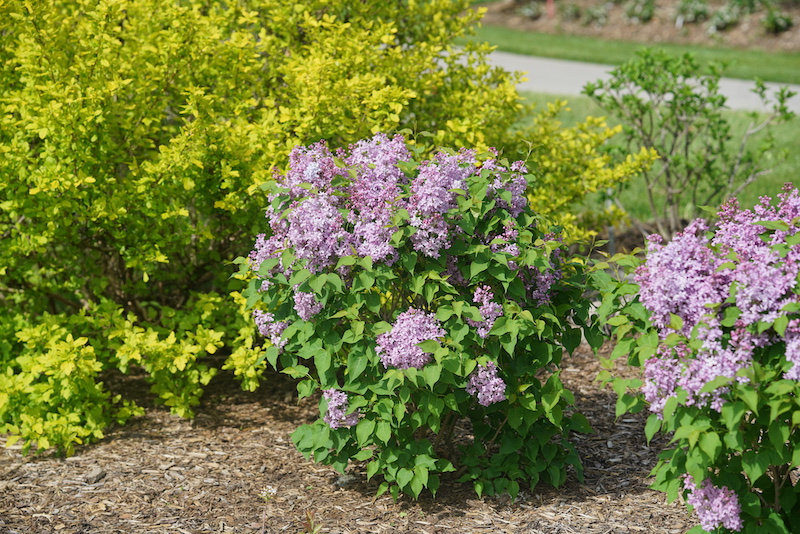Syringa shrubs, more commonly called Lilac, are a quintessential late spring bloomer. The irresistible and nostalgic scent of Lilac is unforgettable. The flowers are not particularly long-lasting when used as a cut flower, but can stay in bloom for weeks on the shrub. Lilacs prefer alkaline soil that is fairly rich in nutrients. This shrub can tolerate a wide range of soil textures. For the best quality blooms and lowest maintenance, plant Lilac with at least 6 hours of direct sun exposure.
Lilacs are traditionally grown as part of a cottage garden or informal hedge plan. The shrub is easily pruned to keep the branch growth dense, making it a good screen plant along a driveway, deck, or property line. Keep in mind that Lilacs require regular watering throughout the growing season no matter how mature the shrub is. Using drip irrigation or soaker hoses for supplemental watering will keep the foliage dry while directing moisture to the roots and surrounding soil.

Shrubs To Plant With Lilac
Lilac is a natural choice when planting an informal, spring-blooming hedge. Pick Lilacs that have a range of blooming times to extend the enjoyable fragrance until well into the early summer. Other deciduous spring shrubs can be planted with Lilac to produce an ever-changing color display from March to June. Beauty bush, ninebark, forsythia, dogwood, purple leaf sand cherry, viburnum, and spirea are all great choices. Broadleaf evergreens make a great backdrop for Lilacs in bloom. Barberry, cotoneaster, and osmanthus come in a range of fantastic colors to pair with the typically solid green and glossy Lilac leaves. Ensure that any shrub you plant with Lilac tolerates alkaline to neutral soils.

Photo by F. D. Richards, unmodified, Flickr, copyright CC BY-SA 2.0 DEED
Perennials To Plant With Lilac
Perennials are easy to pair with Lilacs. Early blooming perennials often are highly fragrant and will give your garden an amazing perfume when blooming at the same time as Lilacs. Peonies, tuberose, lily of the valley, grape hyacinth, and other spring bulbs have distinctive, irresistible scents. Later blooming perennials such as daylilies, iris, lady’s mantle, and autumn sedum will benefit from a backdrop of the Lilac's deep green color and also appreciate the small amount of shade the shrubs may cast as they get older.
Another great partner, clematis can be left to ramble through the Lilac’s branches with no fear that the Lilac will be overwhelmed or harmed by the clematis. The shade at the roots and the sun above the canopy are the precise conditions that clematis prefers. Hostas, ferns, and columbine make a lovely permanent ground cover to keep the soil around Lilacs cool and to suppress weeds.
Annuals To Plant With Lilac
The best annuals to pair with Lilacs are ground covers that both suppress weeds and add seasonal color. Annuals that thrive in part shade are great choices because the base of Lilacs is generally quite shady due to their dense foliage growth. Trailing fuchsia, torenia, lobelia, sweet alyssum, begonias, and impatiens are just a few of the more popular shade-loving annuals. Another great aspect of using annuals for ground cover is that a gardener can change color combinations or planting designs yearly for relatively little expense.
Best Companion Plants For Lilacs in Containers
Lilacs can be grown in planters in combination with other plants or as a specimen for a deck, patio, or balcony. Typically smaller varieties of Lilacs are easiest to grow in a pot. Lilacs pruned into tree shapes grow well with shallow-rooted annuals, allowing ever-changing seasonal color combinations. Alyssum, lobelia, impatiens, calibrachoa, and petunias make great fillers and spillers, allowing the Lilac to take center stage while in bloom.

Plants Not To Grow With Lilac
Lilacs do not grow well when planted in acidic soils with rhododendrons, azaleas, blueberries, and many conifer evergreens. Lilacs cannot access all the micronutrients they need in alkaline soils, limiting their growth and overall health over time. Hydrangeas are also not ideal to grow near Lilacs. Both shrubs love water and may compete for moisture in the soil, potentially leading to dehydration in one or both shrubs.
Best Plants To Grow With Lilac
Lilacs are one of the most beloved spring-blooming shrubs to bring color and scent into the garden. They are easy to care for, requiring very little seasonal maintenance, and can be mixed and matched with a wide variety of shrubs, perennials, and annuals. Underplanting lilacs with spring and early summer bulbs is an effective way to create a colorful display to begin the growing season. Include other blooming shrubs such as ninebark, forsythia, dogwood, and viburnum for a low-maintenance shrub border with long-lasting color.
 |
Author Robbin Small - Published 9-08-2023 |




